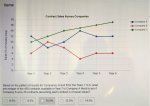Hi everyone, this is the third and the last of my query for this time. Posting the question below:

I understand the graph is giving the sales percentage for each company out of the industry total. Company B winning 36 out of 450 contracts in Year 7 means 8%. I am not sure on how to move forward from this point or if this is related to probability. Any help is highly appreciated! Thank you for reading.
P.S. Moderators, please kindly move this thread to the relevant section if this is a probability related question.

I understand the graph is giving the sales percentage for each company out of the industry total. Company B winning 36 out of 450 contracts in Year 7 means 8%. I am not sure on how to move forward from this point or if this is related to probability. Any help is highly appreciated! Thank you for reading.
P.S. Moderators, please kindly move this thread to the relevant section if this is a probability related question.
